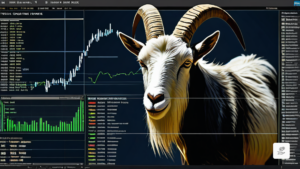Decoding Derivatives: A Comprehensive Guide to Futures and Forwards

Exploring the World of Futures and Forwards
Derivatives play a crucial role in modern finance, offering a diverse range of applications for investors. Among these, futures and forwards contracts stand out as foundational tools that can be utilized for various financial strategies. While these instruments may appear complex at first glance, their potential benefits and risk management capabilities make them indispensable in the world of finance.
Unraveling the Distinctions: Futures vs. Forward Contracts
Futures and forwards contracts share common traits, requiring parties to commit to buying or selling an asset at a predetermined future date. The price is established at the time of contract initiation, serving as a key feature of these derivative products. These contracts find application across different sectors, facilitating risk mitigation and profit enhancement strategies.
For instance, a farmer looking to safeguard against a potential drop in crop prices can utilize futures contracts to lock in a selling price, a practice commonly known as hedging. Similarly, investors can leverage futures contracts to gain exposure to a larger share volume without directly owning the underlying asset, offering a cost-effective alternative to traditional stock purchases.
Engaging in futures or forwards trading demands a thorough understanding of the associated risks, especially concerning leverage. These contracts span various asset classes, including equities, fixed income securities, commodities, and foreign exchange, providing a broad spectrum for investment opportunities.
Deep Dive into Futures Contracts
Futures contracts adhere to standardized terms, mandating investors to buy or sell at a specified price on a future date. These contracts are traded on exchanges, requiring margin deposits and daily settlements. The fixed nature of futures contracts limits customization options, yet provides a level of security through margin utilization for potential losses.
Investors often view futures contracts as a safer option due to the ability to utilize deposited margins for covering losses. However, the lack of flexibility can pose limitations, as terms such as asset selection, pricing, and maturity date are predetermined. Despite these constraints, early contract closure is feasible through counter positions, allowing for strategic adjustments.
Illustrative Example of a Futures Contract
Consider a scenario where an investor intends to acquire crude oil in a year, anticipating a price surge from the current level of $40. Assuming a futures price of $40 per barrel with a standardized contract size of 1,000 barrels, the investor must maintain a margin of 30% on the $40,000 notional value.
Calculating the profit or loss entails comparing the spot price with the futures price, multiplied by the contract volume. In case of a price decline to $39, a loss of $1,000 is incurred, necessitating margin top-up to meet maintenance requirements. As prices further plummet to $35, additional funds are needed to cover losses, highlighting the margin obligations associated with futures trading.
Unveiling the Dynamics of Forward Contracts
In contrast to futures, forward contracts offer non-standardized terms, allowing counterparties to determine asset specifics, pricing, and contract duration. These agreements operate without exchange intermediaries, enabling personalized contract structures without fixed lot sizes. Forward contracts lack daily mark-to-market settlements, presenting potential counterparty default risks on settlement dates.
A practical example involves two parties, Tom and Harris, engaging in a forward contract with an exercise price for Apple shares at $385. If the share price rises to $400 at maturity, Tom gains $15 per share, while Harris, holding a short position, incurs a loss of $15, emphasizing the payoff dynamics of forward contracts.
Comparative Analysis: Futures vs. Forwards
Distinguishing features between futures and forwards are highlighted in the table below, underscoring key contrasts in their operational structures and risk profiles.
Table: Futures vs. Forwards
|Futures | Forward |
|Standardized contracts with fixed lot sizes and maturity dates | Customizable contracts adaptable to asset types, maturity timelines, and sizes |
|Exchange-traded instruments | Over-the-counter products |
|Daily mark-to-market settlements and margin calls | Absence of daily mark-to-market and margin requirements |
|Ease of contract termination through liquid markets | Complexity in terminating unique terms with counterparties |
|Regulated market environment | Direct counterparty involvement without regulation |
|Lower credit risk with exchange supervision | Higher credit risk due to direct counterparty engagement |
|Cost-efficient with minimal exchange fees | Costs tied to contract formulation and due diligence |
Advantages of Futures over Forwards
Futures contracts offer reduced risk exposure and ease of termination through liquid markets, providing regulatory oversight for added security. The streamlined process and lower operational costs make futures an attractive option for risk-conscious investors seeking efficient financial instruments.
Advantages of Forwards over Futures
Forwards present customizable features that cater to individual preferences, eliminating initial margin requirements and regulatory constraints. The simplicity of tracking and settlement at maturity enhance the appeal of forwards, offering flexibility and cost-effective alternatives for tailored derivative transactions.
Market Participants in Futures and Forward Contracts
Trading activities in futures and forward contracts are segmented into two primary categories based on participants’ motives: Hedgers and Speculators. Hedgers aim to mitigate price volatility risks associated with underlying assets, while Speculators seek to capitalize on price movements for amplified returns.
Corporations reliant on specific commodities, such as oil, may engage in futures or forward contracts to hedge against price fluctuations, ensuring financial stability amidst market uncertainties. Speculators leverage derivative contracts to magnify profit potential, albeit with heightened exposure to market fluctuations.
Choosing Between Day Trading Futures and Forwards
For individual traders, futures contracts offer a more accessible avenue for day trading due to simplified requirements and operational transparency. Forward contracts, characterized by bespoke terms and legal intricacies, are better suited for institutional entities with specialized risk management needs. Entry into derivative trading necessitates foundational knowledge and strategic acumen to navigate the inherent complexities.
Frequently Asked Questions (F.A.Q)
1. What determines the payoff in futures and forward contracts?
The payoff calculation hinges on contract unit volumes and price differentials, irrespective of the contract type traded.
2. How do demand dynamics impact forward and futures contract pricing?
Demand fluctuations can influence contract pricing, potentially leading to inflationary pressures on the underlying commodities.




